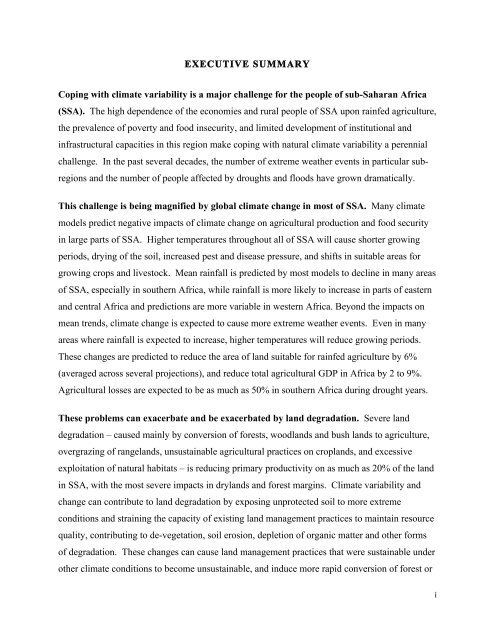The Role of Sustainable Land Management for Climate ... - CAADP
The Role of Sustainable Land Management for Climate ... - CAADP
The Role of Sustainable Land Management for Climate ... - CAADP
You also want an ePaper? Increase the reach of your titles
YUMPU automatically turns print PDFs into web optimized ePapers that Google loves.
!<br />
EXECUTIVE SUMMARY<br />
Coping with climate variability is a major challenge <strong>for</strong> the people <strong>of</strong> sub-Saharan Africa<br />
(SSA). <strong>The</strong> high dependence <strong>of</strong> the economies and rural people <strong>of</strong> SSA upon rainfed agriculture,<br />
the prevalence <strong>of</strong> poverty and food insecurity, and limited development <strong>of</strong> institutional and<br />
infrastructural capacities in this region make coping with natural climate variability a perennial<br />
challenge. In the past several decades, the number <strong>of</strong> extreme weather events in particular subregions<br />
and the number <strong>of</strong> people affected by droughts and floods have grown dramatically.<br />
This challenge is being magnified by global climate change in most <strong>of</strong> SSA. Many climate<br />
models predict negative impacts <strong>of</strong> climate change on agricultural production and food security<br />
in large parts <strong>of</strong> SSA. Higher temperatures throughout all <strong>of</strong> SSA will cause shorter growing<br />
periods, drying <strong>of</strong> the soil, increased pest and disease pressure, and shifts in suitable areas <strong>for</strong><br />
growing crops and livestock. Mean rainfall is predicted by most models to decline in many areas<br />
<strong>of</strong> SSA, especially in southern Africa, while rainfall is more likely to increase in parts <strong>of</strong> eastern<br />
and central Africa and predictions are more variable in western Africa. Beyond the impacts on<br />
mean trends, climate change is expected to cause more extreme weather events. Even in many<br />
areas where rainfall is expected to increase, higher temperatures will reduce growing periods.<br />
<strong>The</strong>se changes are predicted to reduce the area <strong>of</strong> land suitable <strong>for</strong> rainfed agriculture by 6%<br />
(averaged across several projections), and reduce total agricultural GDP in Africa by 2 to 9%.<br />
Agricultural losses are expected to be as much as 50% in southern Africa during drought years.<br />
<strong>The</strong>se problems can exacerbate and be exacerbated by land degradation. Severe land<br />
degradation – caused mainly by conversion <strong>of</strong> <strong>for</strong>ests, woodlands and bush lands to agriculture,<br />
overgrazing <strong>of</strong> rangelands, unsustainable agricultural practices on croplands, and excessive<br />
exploitation <strong>of</strong> natural habitats – is reducing primary productivity on as much as 20% <strong>of</strong> the land<br />
in SSA, with the most severe impacts in drylands and <strong>for</strong>est margins. <strong>Climate</strong> variability and<br />
change can contribute to land degradation by exposing unprotected soil to more extreme<br />
conditions and straining the capacity <strong>of</strong> existing land management practices to maintain resource<br />
quality, contributing to de-vegetation, soil erosion, depletion <strong>of</strong> organic matter and other <strong>for</strong>ms<br />
<strong>of</strong> degradation. <strong>The</strong>se changes can cause land management practices that were sustainable under<br />
other climate conditions to become unsustainable, and induce more rapid conversion <strong>of</strong> <strong>for</strong>est or<br />
!<br />
"!

















